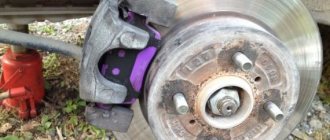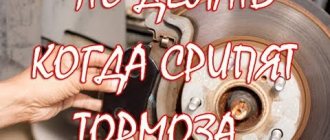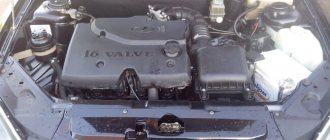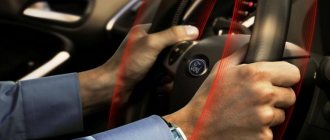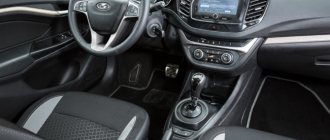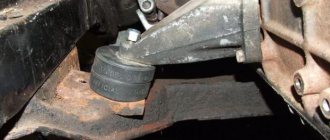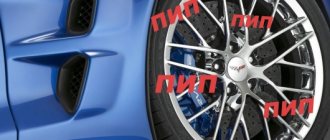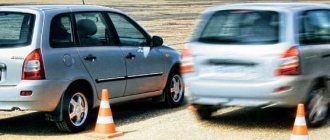Features of brake operation
Brakes may squeal when operating, even if the components are in good condition. This is because the pad can resonate when it rubs against the rotating disc. Therefore, it is equipped with special overhead anti-creaking plates that compensate for resonance. As a rule, manufacturers do not include plates with new pads. When replacing, you must save the old ones and install them. Or purchase a set of anti-squeak plates separately if they are not available.
Other moving parts of the caliper may also resonate. To eliminate this, a caliper maintenance procedure is performed - disassembling the unit with cleaning and lubrication. The guides are lubricated, and a special high-temperature lubricant is placed between the block and the anti-squeak plate.
Thanks to lubrication, the connections are sealed and prevent vibrations. If the brake pads become too hot after prolonged use of the brakes, a squealing noise may also occur. Non-ventilated disks are most susceptible to this; their heat dissipation efficiency is much worse. The whistling usually disappears after it cools down.
Now you know why brake pads whistle or squeak when braking a car, you know how to identify the cause and eliminate the squeak.
What to do when the power steering belt whistles
This problem is easy to fix, since no intervention is required in the design of the pump itself. When the power steering belt whistles, it is enough to maintain its optimal tension. To do this, you need to unscrew the top mount of the device using a hexagon. Now it is possible to rotate the adjusting bolt to adjust the optimal tension. After adjustment, the hydraulic pump mount must be tightened again. After ten kilometers, you should check the tension again, even if there is no whistle. This is necessary in case the fastening was not screwed securely, which helps to loosen the belt again.
So, we have looked at why the power steering belt whistles and how to eliminate this whistle; now we will look at other factors related directly to the design of the power steering itself.
Types of pads and classification
Brake pads are plates with a friction lining. The shape of the lining follows the place of contact with the disc - straight, or the drum - arcuate. The linings are fixed to the body of the pad using glue or metal rivets; The fixation method does not in any way affect the effectiveness of the brakes. Recently, manufacturers have begun to place wear sensors on brake pads.
Despite the fact that manufacturers try to make the alloy composition as unique as possible, most automobile pads contain ceramics, synthetic rubber, organics and mineral bases and modifiers in their structure. The large list of materials used is based on the fact that the pads are subject to significant heating and must not be damaged or lose frictional characteristics in extreme conditions.
In some cases, brake pads heat up to 1000–3000 degrees Celsius.
The first signs that it is time to change the brake pads can be determined by the quality of braking, squeaks and unnatural vibration. The pads are more susceptible to destruction under the influence of water, antifreeze and brake fluid. Brake pads must be replaced in pairs; distinguish front and rear brake pads. Typically, it is the front ones that are subject to greater loads and wear out 3-4 times faster than the rear ones.
Motorists distinguish several types of pads, regarding the material of manufacture:
- Metal. According to reviews, they perfectly withstand high temperature loads. However, they are quite noisy and are most often used on racing cars. Contains steel or copper compounds.
- Organic. The chemical composition includes Kevlar, rubber impurities, glass fibers and organic carbon compounds. Most often used for quiet driving, since such pads are very vulnerable to temperature loads. Among the advantages, car enthusiasts cite low noise levels and a gentle effect on the elements of the braking system.
- Semi-metallic. The structure contains about 70% metal and 30% inorganic compounds. Manufacturers most often use a friction modifier as an additional additive. According to their characteristics, they have a fairly high heat transfer, however, they wear out very quickly.
- Ceramic. They are considered among motorists to be the most efficient, but also the most expensive. They consist mainly of ceramic fibers and non-ferrous metals. Among the advantages: the most gentle effect on discs, low heating and excellent wear resistance.
To choose the best option for yourself, you should not chase price, but quality and compliance with your needs. Purchasing ceramic or metal pads for a fabulous sum will not bring any benefit if the driver prefers a calm driving style.
Naturally, like any other parts, pads can be divided according to the quality of the manufacturer. There are three groups: the highest category, aftermarket and third category. The first usually includes original components. The second class includes manufacturers who allow themselves to deviate by approximately 10% from standard documentation and manufacturing technology. The third category is small manufacturers, little-known companies, products of low quality and low prices.
You can determine the quality and manufacturer by carefully looking at the product labeling. The country where the pads were certified is usually coded before the conformity indicator.
Organic brake pads
The friction layer of such parts includes various materials of organic origin. It can be rubber mixed with glass, fiberglass, carbon compounds, etc. Such elements have a minimum content of metal components (no more than 20 percent).
Pads with organic linings will cope perfectly with moderate driving of a passenger car. At low speeds, a slight pressure on the brake pedal is enough to activate them.
The advantages of these modifications include softness and quietness during braking. This property is ensured by the minimal presence of abrasives. The disadvantages of such pads are their significantly shorter working life compared to other analogues. The friction layer in them is soft, and therefore wears out much faster.
Another disadvantage of organic pads is that they do not tolerate high heat. For this reason, they are installed on budget vehicles, which are not particularly powerful. Most often, such elements will be installed on small cars.
Semi-metallic brake pads
This category of pads will have a higher quality friction layer. They are used in most cars in the budget and mid-price segment. The lining of such a block will consist of metal (up to 70 percent depending on the manufacturing technology). The material is bonded with a composite substance, which gives proper strength to the product.
Useful: IVECO Trucks
This modification is widely used in mechanical means. These pads will be equipped in a passenger car, crossover, small truck, van, SUV or car participating in amateur sports competitions.
The advantages of semi-metallic linings include an increased working life (compared to an organic analogue). This layer also has a high coefficient of friction, withstands intense heat and cools quickly.
The disadvantages of such products include the formation of more dust (more information on how to remove graphite deposits from transport disks is described here). Compared to their organic counterparts, semi-metallic pads produce more noise during braking. This is due to the fact that it will contain a large number of metal particles. To operate effectively, the pads must reach operating temperature.
Ceramic brake pads
The price of such pads will be higher than all those listed earlier. This is due to the fact that their quality is much higher. Ceramic fiber is used as a friction layer in these elements.
The advantages of ceramic pads are excellent responsiveness of the brake pedal. They have a wide range of operating temperatures, although their efficiency in cold temperatures is low. They do not contain metal particles, so these brakes do not make much noise during operation. Ideal for sports cars.
Despite the obvious advantages over the linings mentioned above, the ceramic analogue is not intended for installation on slow transport. They are especially not recommended for use in trucks and SUVs.
So that the motorist can independently determine what material is used to make the pads, manufacturers apply special markings. Markings can be colored or lettered.
The color classification indicates the maximum permissible temperature. This parameter is as follows:
- Black color - used in regular budget cars, as well as models in the mid-price segment. Ideal for daily travel. The product will be effective if it heats no more than 400 degrees.
- Green friction layer - overheating is allowed to a maximum of 650 degrees.
- Red trims are already products for entry-level sports cars. The maximum permissible overheating is 750 Celsius.
- Yellow block - used on professional racing vehicles that participate in events such as circuit racing or track racing. Such brakes are able to maintain their effectiveness up to temperatures of 900°C. This temperature range may be indicated by blue or light blue.
- The orange pad is used only in highly specialized racing vehicles, the brakes of which can heat up to one thousand degrees.
On each pad, in addition to information about the manufacturer and certification, the company can indicate the friction coefficient. This will be a letter sign. Since this parameter changes depending on the heating of the lining, the manufacturer can apply two letters. One indicates the coefficient of friction (CT) at a temperature around 95°C, and the second - about 315°C. This marking will be located next to the catalog number.
Here are the parameters each character corresponds to:
- C – CT up to 0.15;
- D – CT from 0.15 to 0.25;
- E – CT from 0.25 to 0.35;
- F – CT from 0.35 to 0.45;
- G – CT from 0.45 to 0.55
- N – CT from 0.55 or more.
Having basic knowledge about this marking, it will be easier for the driver to choose the right quality pads suitable for specific operating conditions.
Grinding noise in the front wheel: causes and methods of “treatment”
Issues discussed in the material:
- What are the main causes of grinding noise in the front wheels?
- Why does a grinding noise appear around the front wheel when turning?
- In what cases is the problem of extraneous sounds in wheels not as serious as it seems?
Avid motorists know that when operating a car, various minor breakdowns often occur that do not in any way affect its overall performance, but cause discomfort to both the driver and passengers. A grinding noise in the front wheel when driving and braking is just such a case. For what reason does it appear? What needs to be fixed? You will find the answers in our article.
The pads are dusty
Increased dust formation without deterioration in braking performance is not in itself a malfunction. It is related only to the composition of the friction material and driving style. Dust from the pads causes inconvenience only to car owners with cast and forged light-colored wheel rims. The dirt on the rim is too noticeable on them, which does not have a positive effect on the appearance of the car.
Increased dust formation along with a whistle indicate the possible origin of the brake pads being counterfeit. This is especially true for consumables with reduced dust formation from the factory, for example, like products manufactured using TRW’s DTEC technology.
You can get rid of increased dust formation only by replacing the pads with others. Some car owners recommend installing products with a stiffer friction lining. The disadvantage of this solution is that the pads squeak when braking even at low speeds, and the disc is “eaten up” much faster.
Why do brake pads whistle or squeak?
The intensity of stopping a car depends on the condition of the brake pads. During operation, whistling, creaking, knocking, and rattling noises may appear coming from the wheel arches of the car.
The listed symptoms indicate the presence of malfunctions in the brake system. The car owner needs to fix the problems as soon as possible, since otherwise there is a high risk of getting into an emergency.
Bad material
What are the reasons for squeaking brakes other than structural ones? Let's start with a common cause - poor pad material. Why? Any friction lining is a polymer composition of more than two dozen elements. Manufacturers of cheap products save money and use inexpensive composition for their products.
Don't skimp, because brakes are the basis of active safety.
Choose brake discs and pads from the same manufacturer. For example, if you replace original brake discs with Brembo products, then install pads from this company. If they are from different manufacturers, they may turn out to be incompatible with each other and will begin to make unpleasant sounds.
Wear and grinding in
Let's consider the main factors and reasons that can influence the appearance of squeaking when braking.
- Poor quality friction layer. If the car has new pads, but you can hear a squeaking sound, this may indicate their low-quality friction layer: they gather dust, crumble and simply do not fit the brake discs. An unpleasant sound when slowing down may appear due to particles of copper, brass or steel shavings that are used in the production of elements. The whistling and grinding noise disappears after replacing the pads.
- Lapping. If the squeaking occurs from the first days, as soon as new brake bars were installed, then it may take time to break in. The culprit for the sound may be impurities that get onto the pads during production.
- Wear of planks. When the friction layer is completely worn out, friction between the brake disc and the metal base of the pad begins. This also occurs due to improper fastening of the mechanical strip wear sensor.
Break-in of brakes
The squeaking noise occurs when new brake pads are breaking in. If they were recently replaced and they creak, then you should wait, perhaps the unpleasant sound will pass. This happens because there is a certain layer of impurity at the top of the pad that causes the nasty sound. When it is completely abraded, it should disappear. To quickly get rid of the squeak, do intense braking a couple of times (on an empty road).
Squealing brakes also occur due to water ingress or contamination. For example, when we drove through a deep puddle. Therefore, it is worth cleaning (if dirt gets in) or waiting until they dry out.
Other reasons
Each pad has a wear indicator (the so-called “squeakers”), which comes in the form of a metal plate. When the wear indicator pad wears excessively, this plate comes into contact with the brake rotor, resulting in a squealing or squealing sound. This signals their immediate replacement.
This squeak also appears on new pads with a wear indicator. This is due to poor-quality fastening of the plate, as a result of which it will come into contact with the disk prematurely and produce an unpleasant sound.
Car brakes can squeak due to heat and excessive heat. If you drive intensively around the city, alternating braking with acceleration, then even the original pads will creak a little. This occurs on vehicles that do not have ventilated brake discs. They get hot and make unpleasant sounds, but they are not significant and are quickly eliminated when the brakes cool down.
When replacing pads, it is advisable to lubricate the caliper guides with a special lubricant. For this purpose, lubricant for CV joints, grease or other similar ones is suitable. This is another reason why your car brakes make bad noises.
Useful: How to start a car in cold weather? Starting the car
The appearance of a squeak causes discomfort, but does not affect braking efficiency. If you are sure that the squeak is not caused by the pads, then you should inspect and clean the brake system. Possible assembly and disassembly, as well as lubrication of all moving parts, will eliminate unpleasant sounds.
Getting rid of the problem
After diagnostics, it is necessary to eliminate the malfunction. In most cases, the matter ends with the installation of new brake pads. Less commonly, by resurfacing or replacing the brake disc or replacing caliper pistons. Replacing pads on one wheel is not carried out; this is done along the axis of the car, that is, on both front or rear wheels.
However, it happens that the pads squeak even after replacement, but there is no need to worry, in most cases they soon grind in. After just a few hundred kilometers the problem goes away on its own. To speed up this process, some manufacturers produce pads with cuts on the friction part.
If you don't want to wait, you can use anti-squeak grease or paste. It is important to know that the applied composition is not intended to facilitate sliding, so in no case should it get on the moving parts of the system. The paste is applied to the back of the pad rather than the friction surface, which reduces heat during braking and reduces clearances between the pad and disc. It hardens over time, but continues to absorb sound when braking. As a rule, these are compositions based on copper or ceramic powder with the addition of special additives.
To eliminate creaking, anti-creaking plates installed on the outside can be used. Their task is to compact the structure and create a buffer elastic layer that balances the degree of pressing of the pads to the disc.
Rattling pads
The main reasons why pads rattle are given in the table below.
Table - Causes of pad rattling
| Cause | Note |
| Surface melting | As a result, particles of friction material stick to the surface of the disc and it begins to cling to the pads |
| Backlash | Possible for a number of reasons: • the pads are fake; • wear of the steering knuckle; • incorrect selection of consumables; • installation errors. |
| Do-it-yourself modification of the brake system | Trying to adjust the performance characteristics of the braking system to suit themselves, some car owners modernize it. As a result, such actions lead to the pads starting to rattle on the car. |
Vibration and runout
Intense stops of the car heat up the discs. If water gets on their surface, for example, when driving through a puddle, it leads to deformation as a result of sudden cooling. Due to the appearance of bulges, the disc catches the pads while moving and they rattle. The problem can be solved by grooving or replacement. The choice of method depends on the degree of deformation and wear of the disc.
Often brake pads whistle when driving after replacing discs. The reason for this is beating resulting from improper installation. The pads touch the surface of the discs, which is accompanied by a characteristic noise.
Since the wheel rotates quickly while moving, the sound merges into a monotonous whistle. If the disc runout is not eliminated, uneven wear will appear on it, which is not always possible to remove.
Temporary difficulties
The grinding noise may occur after the car has been driven through mud. The sand that gets between the pads and the brake disc is quickly erased into dust and the squeaking stops. If the contamination is serious, it is better not to risk the “health” of the brake system and your own safety. Troubleshooting in a specialized center will not take much time.
A stuck pebble between the disc and the brake shield begins to creak unpleasantly. If this happens, the sound will be heard all the time while driving, regardless of whether the brake pedal is pressed or not. You can remove such an “alien” yourself. Caution—immediately after driving, the brake system components may be hot and you may get burned.
It is difficult to determine the exact cause of the squeak on your own, so if a malfunction occurs, we recommend contacting the official service centers of the FAVORIT MOTORS Group of Companies. Qualified technicians will quickly determine the cause of the “sound” and carry out high-quality repairs.
Diagnosis of brake system faults
When the brakes squeak when braking, it is necessary to identify the cause of the malfunction, because in addition to the unpleasant sound, other problems also appear:
- The braking distance lengthens because the working surface wears out and does not grip the disc as expected.
- To brake, you need to apply more force to the pedal.
- In the event of sudden braking, the pedal often feels beating due to uneven wear of the pads or discs.
You can diagnose the state of the system when the brakes squeak on your own, which requires:
- remove the wheel cover;
- carefully inspect the disc and brake pads;
- a gray coating on them indicates that the working surface is being worn out;
- the appearance of metal particles in the plaque indicates the need to replace the pads.
It is advisable to do such an inspection every two to three thousand kilometers, which will allow you to avoid critical situations. If a whistle is clearly audible when braking, the real picture will be visible after removing the wheel, when the disc and pads are completely exposed. This is due to the fact that it is necessary to evaluate the condition of both the external and internal parts of the pads. If the design does not provide a wear sensor, you need to carefully inspect the pads; if the working lining is worn down to 2 mm, it is best to replace the pads without waiting until the metal begins to scratch the brake disc.
When diagnosing, inspect the brake disc. It wears out slower than pads because it is made of wear-resistant hard metal. It should not have cracks, holes, chips, or visible deformations. To determine the condition, just run your finger and feel the chamfer that appears as a result of wear, and if it reaches 2 mm, the disc is considered worn out. There is still enough metal in it, but it becomes too thin and prone to constant overheating, leading to deformation.
What to do to make new brakes stop squeaking when braking the car at low speed
Actually, if nothing was done before the grinding noise appeared, then this is a call to at least inspect the area around the calipers. Where to look has already been discussed; these cases do not require additional comments. An interesting list of actions in relation to fresh pads, which after installation began to squeak. Replacement immediately is not an option, this is a last resort method.
Lapping in
Give the friction linings time to grind in. After several hundred kilometers of city travel, their working surface will be in full contact with the disk, and this is a reason to stop the whistling, but not the only one.
In relation to pads, the term “molting” is relevant. The fact is that the product includes organic products of the oil refining industry - resins. Overheating, the latter turn into gas, and a gas gasket appears between the friction part and the disk. The effect is similar to hydroplaning of car wheels.
High-quality products undergo “molting” once or twice and only when heated. “When cold,” they do not creak, unlike low-grade models. By the way, the latter's burn-in knows no limits - they will squeak all the time.
Sports pads have their own specifics. If you do not burn through, the brakes on the car will constantly whistle even when braking at low speed. Baking consists of several series of accelerations and decelerations with breaks. The main goal is to overheat the pads to the point where there is smoke in the area of the wheels:
- Stops smoothly from 60 km/h to 0 km/h. Repeat 5 times.
- Drive 1 km without braking.
- Slow down from 80 km/h to 0 km/h. Do it 5 times.
- Drive 2 km without stopping.
- Perform steps 1-4 again.
- Cool the brakes during 5-10 km of non-stop driving.
Lubricate
Never use a work surface! It is necessary to lubricate those areas that are adjacent to the bracket and the surfaces of the caliper. This will help avoid additional vibrations, because not only the friction layer can squeak.
Do not use just anything, but use copper anti-squeak paste (for example, Mannol Kupfer-Paste or Liqui Moly Kupfer-Paste). It does not dry out at high temperatures and is suitable for the prevention of guide supports.
Before installing new pads, it is appropriate to inspect the contact surfaces of the bracket. If there are burrs and wear on them, smooth them out with a needle file. And don’t forget about the caliper guides - they also need lubrication and periodic replacement. By the way, their wear is recorded as the cause of knocking when turning the steering wheel at low speed.
Reassemble the mechanism
There should be anti-squeak plates on the back of the product. They do not always sit tightly on the base adjacent to the brake caliper. If records are left in the box, you should put them back immediately. If it doesn’t help, then use a paste.
Note: constructive measures aimed at preventing whistling
A microscope is not needed to examine engineering tricks. They are of a purely technical nature. We have already talked about one of them - anti-squeak linings on the back of the products. Find out about other means of combating vibration below:
- Bevels and slots on the friction layer move resonant vibrations to higher frequencies.
- The slots perform a role similar to bevels + remove dirt from the contact patch.
- Anti-vibration plates dampen vibrations relative to the piston and caliper bracket.
- Specially curved elements on the back of the pad fit tightly into the working cylinder, which helps to avoid noise in many braking modes.
- Wire brackets dampen vibrations of the friction part along the guide.
- Damping bushings are installed on one of the caliper guide fingers to absorb vibrations.
Drum brakes
In this topic, it is worth highlighting in a separate paragraph the question of why drum-type brake pads squeak.
In many domestic and foreign-made cars, rear brakes are still installed of the drum type. When creaking bars occur in such brakes, the main reasons coincide with the factors causing similar sounds in disc brake systems. But there are also differences caused by design features.
When the strips become dusty after replacing disc brakes, the bulk of the dust from the friction material falls out and does not clog the surface of the pads. And if the friction linings in drum brakes become dusty, then all the dust settles inside the mechanism on the inside of the drum and the surface of the pads.
This is what causes the squeaking noise when the car slows down. In this case, in order to remove the creaking sound, you should periodically clean the surface of the planks from plaque with sandpaper.
Brake squeal caused by foreign object or dirt
If the brake pads are not worn out, but the whistle still appears, you need to remove them and check them for foreign objects and contamination. The pad lining has a transverse slot in the middle, which is designed to collect wear products (dust). When the slot becomes completely clogged, dust comes into contact with the blade and can cause a whistling noise. The whistling noise can cause the stone to get stuck between the working rubbing surfaces, as well as moisture ingress.
The solution to the problem is to disassemble and clean the pads from dirt and wear products. Or you can drive around for a while and watch the whistle. In some cases it goes away on its own.
Normal brake noises
https://www.youtube.com/watch?v=ytcreatorsru
Modern brakes consist of metal brake discs that are sandwiched between two pads coated with a friction material. When the discs, caliper and brake pads are or are in perfect condition, the entire system works properly and when you press the brake hard, you will not hear any unpleasant squealing sound.
Just as for the normal sound of all musical instruments, a tuner is needed, so for the normal adjustment of the brake system, you need a specific professional auto mechanic who, in the event of a brake malfunction, will be able to adjust the brake system of your car to optimal operation.
Reason five - weather conditions
In the autumn, the cause of sounds that occur when you press the brakes is rain falling on the surface of the pads. In winter, this effect is provoked by condensation that appears as a result of temperature changes. Sharp frosts cause a wet coating that occurs when cold air comes into contact with a heated brake disc. The question arises what to do in this case. It would be a good idea to press the brake pedal several times while moving slowly in order to “dry” the disc.
